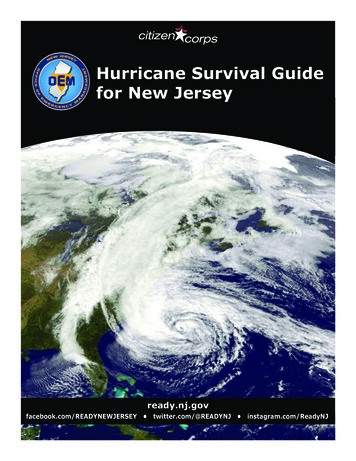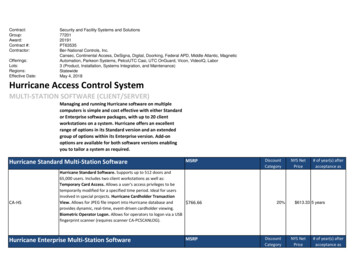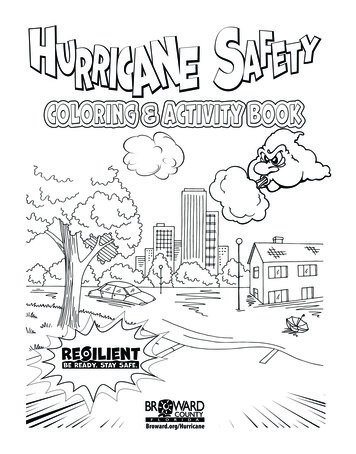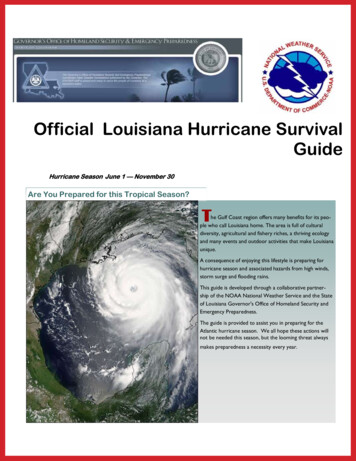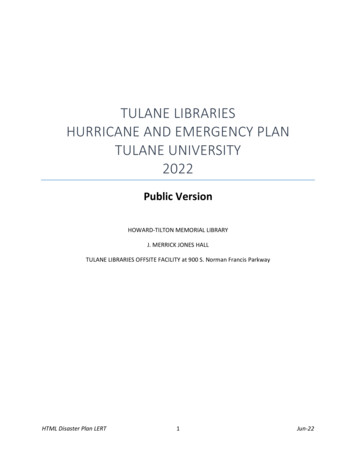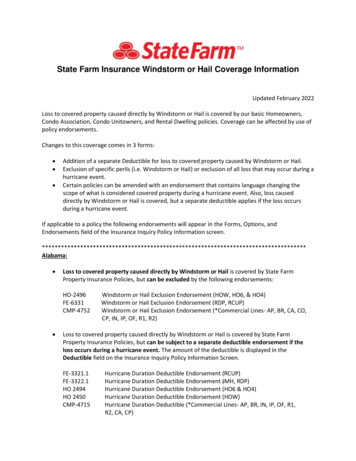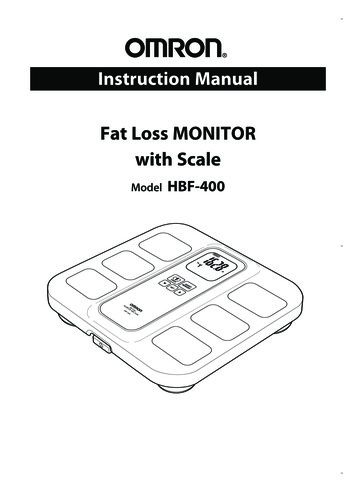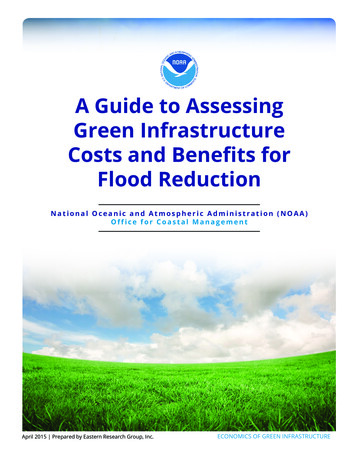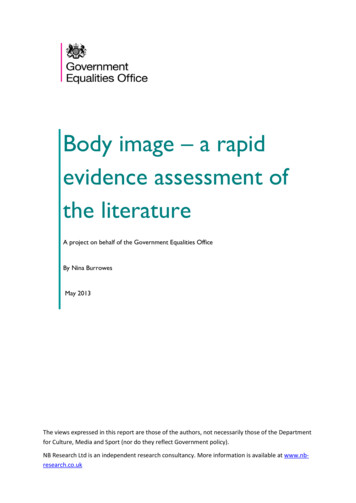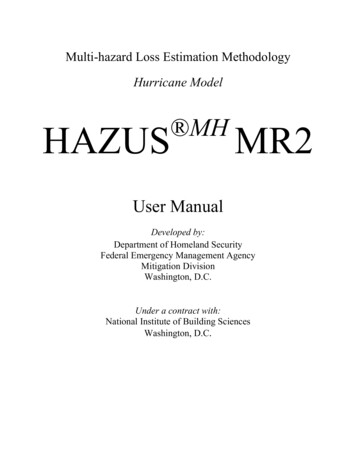
Transcription
Multi-hazard Loss Estimation MethodologyHurricane ModelHAZUS MHMR2User ManualDeveloped by:Department of Homeland SecurityFederal Emergency Management AgencyMitigation DivisionWashington, D.C.Under a contract with:National Institute of Building SciencesWashington, D.C.
iiiFOREWORDThe research and development and studies that provided the basis for this publication wereconducted pursuant to a contract with the Federal Emergency Management Agency (FEMA)by the:The National Institute of Building Sciences (NIBS), located in Washington, DC, is a nongovernmental, non-profit organization, authorized by Congress to encourage a more rationalbuilding regulatory environment, to accelerate the introduction of existing and newtechnology into the building process and to disseminate technical information.Copies of this report are available through the Federal Emergency Management Agency. Forinformation contact FEMA @ www.fema.gov/hazus or:FEMA Distribution CenterP.O. Box 2012Jessup, Maryland 20794-2012Tel.: 1 800-480-2520Fax: 301-362-5335HAZUS is a trademark of the Federal Emergency Management Agency.HAZUS-MH MR2 User Manual
ivHAZUS-MH MR2 User Manual
vACKNOWLEDGMENTSHAZUS-MH, HAZUS-MH MR1 and HAZUS-MH MR2Hurricane Model Methodology DevelopmentWind CommitteeChairman, Joseph Minor, Consultant, Rockport, TexasArthur Chiu, University of Hawaii, Honolulu, HawaiiMark Levitan, Louisiana State University, Baton Rouge, LouisianaRichard Marshall, Consultant, Poolesville, MarylandRobert McComb, Texas Tech University, Lubbock, TexasKishor Mehta, Texas Tech University, Lubbock, TexasDale Perry, Texas A&M University, College Station, TexasMark Powell, National Oceanic and Atmospheric Administration, Miami, FloridaDouglas Smits, City of Charleston, Charleston, South CarolinaMasoud Zadeh, Consultant, San Jose, CaliforniaApplied Research Associates, Inc., Raleigh, North CarolinaPeter Vickery, Project Manager; Lawrence Twisdale, Jr., Project Manager; Jason Lin,Peter Skerlj, Michael Young, Francis Lavelle, Reddy Kadasani, Chris Driscoll, KevinHuang, Peter Montpellier, Andrew Steckley, Jeffrey Sciaudone, Yingzhao Chen, DhirajWadheraConsultantsImpact Forecasting, Chicago; Illinois, Sethu Raman, North Carolina State University,Raleigh, North Carolina; Thomas Smith, TLSmith Consulting, Rockton, Illinois; TimothyReinhold, Clemson University, Clemson, South CarolinaHurricane Model Software DevelopmentSoftware CommitteeChairman, Dick Bilden, Consultant, Reston, VirginiaCo-Chairman, Mike Haecker, Consultant, Austin, TexasDan Cotter, Terrapoint, The Woodlands, TexasGerry Key, Computer Sciences Corporation, San Diego, CaliforniaTracy Lenocker, Lenocker and Associates, Inc., Orange, CaliforniaKen Lewis, KVL and Associates, Inc., Scottsdale, ArizonaFrank Opporto, DHS, EP&R Directorate (FEMA), Information Services TechnologyDivision, Washington, D.C.Dirk Vandervoort, POWER Engineers, Inc., Boise IdahoLeslie Weiner-Leandro, DHS, EP&R Directorate (FEMA), Information ServicesTechnology Division, Washington, D.C.HAZUS-MH MR2 User Manual
viApplied Research Associates, Inc., Raleigh, North CarolinaFrancis Lavelle, Project Manager; Chris Driscoll, Reddy Kadasani, Richard Pearson,Jr., Peter Vickery, Steve Brooks, Andrew SteckleyBeta Test Subcommittee – HAZUS-MHDarryl Davis, Corps of Engineers Hydrologic Engineering Center, Davis, CaliforniaNeil Grigg, Colorado State University, Fort Collins, ColoradoCharles Kircher, Kircher & Associates, Palo Alto, CaliforniaTracy Lenocker, Lenocker and Associates, Inc., Orange, CaliforniaKenneth Lewis, KVL and Associates, Inc., Scottsdale, ArizonaMasoud Zadeh, Consultant, San Jose, CaliforniaBeta Test Communities – HAZUS-MHDivision of Emergency Management, Tallahassee, Florida; Washington State EmergencyManagement, Camp Murray, Washington; Whatcom County Public Works, Bellingham,Washington; Johnson County, Olathe, Kansas; Mecklenburg County StormwaterServices, Charolotte, North Carolina; Louisiana State University, Baton Rouge,Louisiana; Charleson County Building Services, North Charleston, South CarolinaBeta Test Subcommittee – HAZUS-MH MR1Douglas Bausch, Department of Homeland Security, Federal Emergency ManagementAgency, Washington, D.C.Richard Eisner, Governor's Office of Emergency Services, Oakland, CaliforniaJohn Knight, South Carolina Emergency Management Division, Columbia, SouthCarolinaKevin Mickey, The Polis Center, Indianapolis, IndianaMark Neimeister, Delaware Geological Survey, Newark, DelawareLynn Seirup, New York City Office of Emergency Management, New York, New YorkBeta Test Subcommittee – HAZUS-MH MR2Douglas Bausch, Department of Homeland Security, Federal Emergency ManagementAgency, Washington, D.C.John Knight, South Carolina Emergency Management Division, Columbia, SouthCarolinaKevin Mickey, The Polis Center, Indianapolis, IndianaJoe Rachel, Department of Homeland Security, Federal Emergency Management Agency,Washington, D.C.Ken Wallace, Department of Homeland Security, Federal Emergency ManagementAgency, Washington, D.C.Bryan Siltanen, Advanced Systems Development, Inc., Arlington, VAHAZUS-MH and HAZUS-MH MR1 Shell DevelopmentPBS&J, Atlanta, GeorgiaMourad Bouhafs, Program Manager; Pushpendra Johari, Sandeep MehndirattaSpecial thanks to ESRI for its assistance in coordinating ArcGIS with HAZUS-MHHAZUS-MH MR2 User Manual
viiProject Sponsorhsip and OversightDepartment of Homeland Security, FEMA, Mitigation Division, Washington, D.C.Frederick Sharrocks, Section Chief, Assessment & Plan for Risk; Cliff Oliver, Chief, RiskAssessment Branch; Edward Laatsch, Chief, Building Science and Technology; EricBerman, Project Officer; Claire Drury, Project Officer; Paul Tertell, Michael Mahoney,Stuart Nishenko, ScottMcAfee, Paul BryantFEMA Technical MonitorsDouglas Bausch, FEMA Region 8; Mark Crowell, Physical Scientist; John Ingargiola,Douglas Bellemo, Allyson Lichtenfels, Divisional CoordinationSpecial thanks to the National Aeronautics and Space Administration for providing financialassistance for developing tree debris estimation capability in the Hurricane ModelProgram ManagementNational Institute of Building Sciences, Washington, D.C.Philip Schneider, Director, Multihazard Loss Estimation Methodology Program;Barbara Schauer, Senior Project ManagerHAZUS-MH MR2 User Manual
viiiHAZUS-MH MR2 User Manual
ixMESSAGE TO USERSThe HAZUS Hurricane Model is designed to produce loss estimates for use by federal, state,regional and local governments in planning for hurricane risk mitigation, emergencypreparedness, response and recovery. The methodology deals with important aspects of thebuilt environment, and a wide range of different types of losses. Extensive national databasesare embedded within HAZUS, containing information such as demographic aspects of thepopulation in a study region, square footage for different occupancies of buildings, andnumbers and locations of bridges. Embedded parameters have been included as needed.Using this information, users can carry out general loss estimates for a region. The HAZUSmethodology and software are flexible enough so that locally developed inventories andother data that more accurately reflect the local environment can be substituted, resulting inincreased accuracy.Uncertainties are inherent in any loss estimation methodology. They arise in part fromincomplete scientific knowledge concerning hurricanes and their effects upon buildings andfacilities. They also result from the approximations and simplifications that are necessary forcomprehensive analyses. Incomplete or inaccurate inventories of the built environment,demographics and economic parameters add to the uncertainty. Where inventories,demographics and economic parameters track closely those assumed and built into the basicmethodology, estimates of loss should be within a factor of two. Where one or more of theseparameters are incomplete or inaccurate the range of uncertainty may exceed a factor of twoor more.The hurricane loss estimation methodology is based on sound scientific and engineeringprincipals and experimental and experience data. The methodology has been tested againstthe judgment of experts and, to the extent possible, against records from several pasthurricanes. However, limited and incomplete data about actual hurricane damage precludescomplete calibration of the methodology. Nevertheless, when used with embeddedinventories and parameters, the HAZUS Hurricane Model has provided a credible estimate ofsuch aggregated losses as the total cost of damage.Users should be aware of the following specific limitations: While the HAZUS Hurricane Model can be used to estimate losses for an individualbuilding, the results must be considered as average for a group of similar buildings. Itis frequently noted that nominally similar buildings have experienced vastly differentdamage and losses during a hurricane. The Hurricane model contains definitions and assumptions regarding buildingstrengths that represent a norm for construction in hurricane zones. These norms aredefined in the technical manual. Where construction quality is known to be differentfrom the defined norms, larger uncertainties in loss projections may be realized.HAZUS should still be regarded as a work in progress. Additional damage and loss data fromactual hurricanes and further experience in using the software will contribute toHAZUS-MH MR2 User Manual
ximprovements in future releases. To assist us in further improving HAZUS, users are invitedto submit comments on methodological and software issues by letter, fax or e-mail to:Philip SchneiderNational Institute of Building Sciences1090 Vermont Ave., N.W.Washington, DC 20005Tel: 202-289-7800 ext. 127Fax: 202-289-1092E-Mail: HAZUSGenHelp@nibs.orgHAZUS-MH MR2 User ManualEric BermanDepartment of Homeland SecurityFederal Emergency Management AgencyMitigation Division500 C Street, S.W.Washington, DC 20472Tel: 202-646-3427Fax: 202-646-2787E-Mail: Eric.Berman@dhs.gov
xiLIMITATIONS OF THE HAZUS-MH MR2 SOFTWAREInstallation HAZUS-MH MR2 is certified to run on ArcGIS 9.1 SP1. Tests have shown thatHAZUS-MH MR2 is unable to fully function on the ArcGIS 9.1 platform only, SP1 isrequired. ArcGIS 9.1 SP1 is available from the ESRI website. HAZUS-MH MR2 is certified to run on MS Windows 2000 SP2, SP3 and SP 4 andWindows XP SP1 and SP2. A user is allowed to install HAZUS-MH MR2 on MSWindows 2000 and XP for Service Packs higher than SP4 and SP2 respectively, butHAZUS-MH MR2 is not certified to work flawlessly with those service packs. HAZUS-MH MR2 must be uninstalled only with the Windows Add/Remove Programsutility. For details on uninstalling, please consult the User Manuals. Users who plan to operate HAZUS-MH MR2 in a network environment will be able toperform HAZUS operations, such as importing, but not study region creation.Study Region Size The database management system of HAZUS-MH MR2 is SQL Server MSDE. Thissystem has a size limit of 2 GB per database, which limits the size of the regions to 2,000census tracts or 90,000 census blocks if the study region also utilizes the Flood Model.Two thousand census tracts and 90,000census blocks are equivalent to an area with apopulation of about 9 million. For a multi-hazard study region that includes data for allthree hazards, the 2 GB limit will permit an even smaller study region. To work aroundthis, the full version of Microsoft SQL Server 2000 Personal and Developer Editionsmust be used (see Appendix N in the user manuals). Multihazard loss analysis capability is limited to the 23 states that experience hurricane,flood and earthquake hazards and requires that the user first run annualized losses foreach of the three hazards. To maximize the size of a study region that may be analyzed, set the virtual memory sizefrom a minimum of 2048 MB to a maximum of 4096 MB. For the earthquake model,the virtual memory size may be increased from a minimum of 1024 MB to a maximum of2048 MB for optimal operation. Here are the steps for setting the virtual memory size:1.2.3.4.5.6. Click on Start Settings Control Panel System Click on the Advanced TabClick on the Performance Options buttonClick the Change button under Virtual MemoryReplace the initial and maximum valuesClick ApplyThe HAZUS-MH MR2 installation allows the user to specify the folder where the statedata will be copied through the "Choose Data Path" dialog in the installation wizard. If,at the time of installation, the user specifies the folder where the data will be copied afterHAZUS-MH MR2 User Manual
xiiinstallation, they only need to perform Step 1 as described below. If at the time ofinstallation the User does not specify the folder where the state data will be copied by theuser after installation, or if they want to change the folder specified during installation,then Steps 2 through 4 for updating the Registry should be completed.NOTE: The "Choose Data Path" dialog in the installation process only specifies thefolder where the state data will be copied by the user from the DVD after installation hascompleted. This dialog doesn't copy the data from the DVD to the specified folder; thathas to be done manually by the user after installation.1. Copy one or more of the state data folders (e.g., NC1), both the DVD identificationfiles (e.g., D1.txt 4.txt) and "syBoundary.mdb" from the Data DVD to a folder onyour hard drive (e.g., D:\HAZUSData\). As an example, the following graphicillustrates how the data for the state of South Carolina would be organized under theHAZUS Data folder.2. Next, point the program to the data folder on your local hard drive. To do this, click the"Start" button and select "Run" to open the Run window, type "regedit" in the Runwindow edit box and click the "OK" button to open the Registry Editor. Navigatethrough the folders listed in the Registry Editor to the following location:HKEY LOCAL MACHINE SOFTWARE FEMA HAZUS-MH General3. Now look at the right side of the window and find the entry called "DataPath1".Double click on "DataPath1" to open the Edit String window and enter the full nameof the folder on the hard drive that contains the data copied from the DVDs in the editbox. Click the OK button to update the DataPath1 value.IMPORTANT: Make sure the path ends with a "\" and do not change any of the otherregistry settings.4. Close the Registry Editor by choosing Exit from the File menu of the Registry Editor.Capabilities Transferring data, including importing study regions, from HAZUS-MH to HAZUS-MHMR2 will require the assistance of technical support. Inventory data and subsequently the Level 1 analysis functionality are unavailable for theUS held territories. Components of independently developed data sets in the default inventory data might notline up on maps, for example, the placement of bridges and roads, and facilities. Thissituation can be addressed by updating the default inventory data with user supplied data. The Hurricane Model can be run for 22 states on the Gulf and Atlantic coasts and for thestate of Hawaii. Default tree inventory data is not available for Hawaii. Loss estimates for large study regions of 2,000 census tracts or blocks might require 4hours analysis time.HAZUS-MH MR2 User Manual
xiiiBIT and InCAST In the Hurricane Model, BIT does not allow mapping from specific to general buildingtypes. Since InCAST development predated the development of the Hurricane Model inHAZUS-MH, data types used for different types of hazard specific data in InCAST arenot compatible with those used in HAZUS-MH MR2. Additionally, InCAST does notcapture all hazard specific attributes used in HAZUS-MH MR2. InCAST can be used to capture hurricane hazard data which can be imported intoHAZUS-MH MR2 from hzIncast table. However, the following fields should not beimported: BldgType, Kitchen, Dinning and Sleeping.Technical Support Technical support is available via telephone, e-mail, or FAX. The numbers and addressesare listed on the HAZUS software package and under the Help menu in the software.Information on HAZUS updates, software patches, and FAQs are available atwww.fema.gov/hazus/.HAZUS-MH MR2 User Manual
xivHAZUS-MH MR2 User Manual
xvWHAT’S NEW IN HAZUS-MH MR1 – HURRICANE MODELData Updated valuations for the general building stock.Methodology Capability to assess hurricane mitigation options for multi-unit buildings andmanufactured housing. Capability to define hurricanes with NWS forecasts/advisories downloaded directlyfrom the Internet.Other Features Operation on the new ArcGIS 9.0 SP1 platform. Capability to utilize third-party tools. Optimized software for rapid loss assessment.HAZUS-MH MR2 User Manual
xviHAZUS-MH MR2 User Manual
xviiWHAT’S NEW IN HAZUS-MH MR 2 – HURRICANE MODELData 2005 valuation data for all occupancy classes. Means location factors for residential and non-residential occupancies on a countybasis. Updated and validated valuation data for single-family residential housing andmanufactured housing based on comparisons with other national databases. Zeros substituted for any negative values calculated for the daytime, nighttime,working commercial, working industrial and commuting populations. Construction age and values by decade for every census block with floor area (squarefootage).Methodology Availability of mitigation analysis options for all building classes and capability tospecify the percentages of each building class that have one or more mitigationfeatures. Capability to estimate tree debris weight or volume that is likely to be collected anddiscarded at public expense. Capability through an “Automatic Outputs” tool in the analysis options window tospecify a standard set of summary reports and map layers that will be generated aftereach analysis and automatically exported to the study region folder. Capability to generate a range, representing the 5th and 95th percentiles, of potentialdamage and loss estimates for a given hurricane forecast, based on track and intensityerrors in forecast advisories issued during the past 12 years, and to include the resultsin a new rapid loss summary report. Minor adjustments to the Hurricane Model Summary Reports to improve consistencyamong the three models.Other Features Keyboard operation of all user interface operations with some exceptions. Operation on the ArcView 9.1 SP1 platform. Certified on Windows XP SP2. Operation on the MDAC 2.8 data access engine from Microsoft.HAZUS-MH MR2 User Manual
xviiiHAZUS-MH MR2 User Manual
xixTABLE OF CONTENTSTABLE OF CONTENTS.XIXLIST OF FIGURES.XXIIILIST OF TABLES. XXVIICHAPTER 1.INTRODUCTION . 1-11.1Background . 1-11.2Scope . 1-21.3Overview of the Methodology. 1-31.4Hurricane Hazards Considered in the Methodology . 1-51.5Types of Buildings and Facilities Considered in the Hurricane Model. 1-51.6Levels of Analysis. 1-61.6.1 Analysis Based on Default Information. 1-61.6.2 Analysis with User-Supplied Inventory . 1-71.6.3 Analysis with Advanced Data . 1-71.7Assumed Level of Expertise of Users . 1-81.8Displaying Results. 1-91.9Uncertainties in Loss Estimates . 1-91.10 Applying Methodology Products. 1-91.11 Organization of the Manual . 1-11CHAPTER 2.INSTALLING AND STARTING HAZUS . 2-12.1System and Software Requirements. 2-12.2Installation . 2-22.3Upgrading from HAZUS99 to HAZUS-MH . 2-72.4Starting the Program . 2-82.5Uninstalling the Program . 2-82.6Program Basics . 2-92.6.1 Menu Bar . 2-102.6.2 Toolbar . 2-112.7Limitations of Use for the Hurricane Model . 2-112.7.1 Freeing Memory Using SQL Server Manager . 2-132.7.2 Increasing Virtual Memory to Run Large Study Regions . 2-14CHAPTER 3.RUNNING HAZUS WITH DEFAULT DATA . 3-13.1Defining the Study Region . 3-13.2Defining a Hurricane Hazard . 3-43.3Running an Analysis Using Default Data . 3-43.4Viewing Analysis Results . 3-6HAZUS-MH MR2 User Manual
xx3.5Default Databases and Default Parameters. 3-83.5.1 Default Databases . 3-83.5.2 Default Parameters. 3-9CHAPTER 4.DATA NEEDED FOR A MORE COMPLETE LOSS ESTIMATION STUDY. 4-14.1Developing a Regional Inventory . 4-14.2Standardizing and Classifying Data . 4-34.3Inventory Databases . 4-44.4Inventory Requirements . 4-64.5Relationship Between Building Types and Occupancy Classes. 4-6CHAPTER 5.COLLECTING INVENTORY DATA . 5-15.1Sources of Information . 5-15.1.1 General Building Stock . 5-25.1.1.1 County Tax Assessor Files. 5-25.1.1.2 Commercial Sources of Property Data. 5-35.1.2 Occupancy to Model Building Type Relationships . 5-55.1.3 Essential Facilities . 5-55.1.3.1 Medical Care Facilities . 5-55.1.3.2 Fire Stations, Police Stations and Emergency Operations Centers. 5-55.1.3.3 Schools . 5-55.1.4 User-Defined Facilities. 5-65.1.5 Demographics. 5-65.1.6 Direct Economic Loss Parameters . 5-65.1.6.1 County Business Patterns . 5-65.1.6.2 Means Square Foot Costs. 5-75.1.6.3 Dun and Bradstreet . 5-75.1.6.4 Capital-Related Income . 5-85.2Collecting Inventory Data . 5-85.3Inventory Menu Items. 5-95.3.1 General Building Stock . 5-95.3.1.1 Square Footage . 5-95.3.1.2 Building Count . 5-95.3.1.3 Dollar Exposure . 5-105.3.2 Essential Facilities . 5-115.3.3 High Potential Loss Facilities. 5-115.3.4 User-Defined Facilities. 5-125.3.5 Transportation Systems. 5-125.3.6 Utility Systems . 5-135.3.7 Hazardous Materials. 5-145.3.8 Demographics. 5-145.3.9 View Classification. 5-15CHAPTER 6.ENTERING AND MANAGING DATA IN HAZUS . 6-16.1Importing Features and Files . 6-16.1.1 Importing Site-Specific Data Files . 6-16.1.2 The Import Database Utility . 6-26.2Adding Records to Site Specific Databases. 6-46.2.1 Adding Features Using the Study Region Map . 6-46.2.2 Adding Records to the Attribute Table. 6-66.2.3 Errors When Adding Records. 6-7HAZUS-MH MR2 User Manual
xxi6.3Deleting Records from Site Specific Databases . 6-76.4Editing Records . 6-7CHAPTER 7.DISPLAYING AND MODIFYING INVENTORIES. 7-17.1Editing a Database . 7-17.2Printing a Database. 7-17.3Mapping a Database . 7-17.4Defining Occupancy to Model Building Type Relationships. 7-17.4.1 Defining Specific Occupancy to General Building Type Mapping Schemes . 7-17.4.2 Defining Specific Building Type Mapping Schemes . 7-47.4.3 Defining Wind Building Characteristics Distributions. 7-67.4.4 Applying Mitigation to the General Building Stock. 7-7CHAPTER 8.BUILDING-DATA IMPORT TOOL (BIT). 8-18.1Getting Your Data in the Right Format. 8-18.2Starting BIT . 8-18.3Specifying the Input File . 8-28.3.1 Importing an ASCII Delimited Database. 8-28.3.2 Importing a *.mdb
HAZUS-MH MR2 User Manual ix MESSAGE TO USERS The HAZUS Hurricane Model is designed to produce loss estimates for use by federal, state, regional and local governments in planning for hurricane risk mitigation, emergency
